WeWork, one of the world's largest providers of managed co-working spaces, says that flexibility is a measure of how well we deal with the unexpected. It's a tool we can use to build resilience, and to train people how to think about their problems more creatively in work and life.
So what happens when we're not flexible?
Well, according to WeWork's apt description, if flexibility is an indicator of how well people deal with the unforeseen, then a lack of flexibility is a measure of their stress levels during unexpected challenges.
Flexible people are more resilient, and they think more laterally about solving their problems, whereas inflexible people are less resilient, and become easily overwhelmed when they're faced with changing environments.
Biologically, we're hardwired to survive precisely because we have a built-in ability to adapt and thrive in different environments, which is the end product of our inherent human desire for greater flexibility.
When we can't be flexible, we can't adapt. When we can't adapt, we can't thrive.
People who adapt well and have high levels of resilience are generally happier and more confident than those with lower resilience, which makes them mentally strong, well-balanced, and generally easy to get along with. Hiring flexible people not only creates a more positive workforce, it also encourages innovation, which in turn promotes the desire for greater flexibility.
Employees who are not offered opportunities to work flexibly are limited in their abilities to solve problems and adapt to unexpected situations.
Limited flexibility reduces people's natural resilience. It takes away from the full scope of the problem-solving skills they have at their disposal, and makes them feel more stressed at work.
So how can Employers become more flexible?
9 Ways to Increase Workplace Flexibility
Workplace flexibility is not just about letting people work from home occasionally. Flexible employees should be given a certain level of autonomy that lets them feel in control of their own work experience.
Take a look at these 9 simple ways to increase workplace flexibility, so you can help people thrive with confidence in a naturally autonomous workplace.
1.Flexibility To Make Decisions
Micromanagement causes people to believe they're incompetent, which undermines their confidence. One of the surest signs of micromanagement is an environment where every decision must be pre-approved by management, which limits people's abilities to apply their own initiative.
In an article published by Forbes that says the controlling nature of micromanagement amounts to bullying, 71% of employees reported being negatively affected by micromanagement, while 39% actually changed jobs to avoid their micromanager.
Duty managers and the lines of authority play an important role in key decisions like budgeting and setting KPIs, but employees should be allowed to make quick decisions on the go to avoid feeling micromanaged. This is particularly important in roles that are customer-facing or rely on the employees building positive rapport with clients.
Gallup poses a simple test question for determining decision-flexibility:
"Is the team customer-obsessed, or boss-obsessed?"
If your team is boss-obsessed, then it may be time to loosen the reins and let them make their own decisions without management's rigid pre- approval process.
2. Flexibility To Choose Tasks

Way back in 2013 - long before the fatigue of covid and the hybrid workforce hit the headlines - Forbes published an article simply called, 'How To Work Well When You're Tired.' It's filled with sage advice about staying well, drinking water, and breaking bigger projects down into smaller tasks.
According to Forbes, the easiest way to work well when you're tired is to do routine tasks like replying to emails and filing paperwork.
The problem with tiredness and workplace fatigue is that it's a product of the daily grind, and not something that can be easily predicted in advance or worked into an annual flexibility schedule.
Employees should be given flexibility in their daily tasks, so they can choose to work on the easy stuff when they're struggling to focus, and can sink their teeth into the nice juicy projects when they're at their most productive.
3. Flexibility To Adjust A Workspace
Flexible workspaces are adaptable environments that can tailor to suit an individual's needs. Companies create multi-functional rooms using less space, and people work where they're most comfortable at any time.
Some people may sit in a sofa-style breakout room, while others might choose a bar stool at the kitchen table or work in a quiet meeting room. Today, many businesses are also looking at ways to integrate technology into their workspaces to help hybrid workers feel more present in shared meetings.
Some of the global leaders in flexible workspaces are technology giants who are seeking out new ways to blend functionality with modern flexible work patterns.
Google has created flexible spaces on wheels to allow people to become more playful in their daily work. Components of the office fit together like Lego, with everything from blow-up walls to kitchens on wheels. Googlers are encouraged to have fun with it, which brings a sense of personalised planning into people's days.
To create the perfect workspace elements, Google looks at what people keep aside for themselves, and designs bespoke workspaces to give them more of the things that are really important to them.
Microsoft has an outdoor collaboration space designed to look and feel like a treehouse, which gives employees a back-to-nature work experience that sparks their imaginations some twelve feet off the ground. Microsoft's blog says:
"Welcome to a new kind of workspace that’s helping employees benefit from what science shows is the powerful impact of nature on creativity, focus, and happiness."
4. Flexibility To Work From Different Locations

According to Google's philosophy, employees should receive a menu of choices about where they would like to work. Some choose to work from home, while others prefer the office or a third space location like a coffee shop or a co-working desk.
Employees at Google are offered the option to relocate to a different office anywhere in the world, which can be replicated by smaller businesses who allow their employees to work as digital nomads while they travel.
People should be asked where they will be happiest, most productive, and well-supported, then encouraged to work from the location that can best give them what they really need.
5. Flexibility To Work Variable Hours
Split shifts, compressed hours, 4-day weeks, annualised hours and job shares are just some of the ways that flexible working helps employees to find their work-life balance.
Graham Joyce, co-founder of DuoMe, was recently interviewed by HR Magazine. When asked about compressed hours becoming more commonplace, he said:
“Compressed hours have been around for a long time, but tended to be available in positions with more strict hours. This appears to be changing with key employers, like the UK Government, offering compressed hours as a working pattern that can even be searched for across their advertised jobs.”
Productive people who become bored easily can find work more stimulating when they can just plough through it in less time, which has the added advantage of giving them more time back for other things in their daily personal lives.
6. Flexibility To Change Their Minds
Micromanagement is renowned for minimising active decision-making, but it's just as adept at creating fear in the workplace. People need to have the flexibility to change their minds, which harnesses their power of cognitive flexibility and makes them better equipped to deal with stress.
Allowing employees to change their mind about where they choose to work, how they feel like using their workspace, or which tasks they're working on at any given time. This means that managers can develop their teams' elastic thinking skills while simultaneously giving people a fundamental freedom of choice that keeps them happy.
Freedom of choice, greater autonomy, and elastic thinking boosts creative problem-solving. It makes people want to work more effectively of their own accord.
7. Flexibility To Explore Their Curiosity
Talented people like to improve everything they touch. They look at the world with inherent curiosity and wonder how they can make it better.
When employees are given the flexibility to question the status quo and to explore new ways of doing things that can make their workplace even more effective, then it's in the company's own best interests to listen to their ideas, because the people who come up with great ideas usually are the ones that change the world.
Richard Branson, who employs 70,000 people with stakes in 400 different companies, says:
“I surround myself with people who have knowledge and talents in areas where I might not be so well versed.”
Curiosity leads to discovery, and discovery leads to innovation.
8. Flexibility To Stretch New Skills
People are motivated by their capacity to learn, so skills training is one of the easiest ways to boost morale. This helps people feel confident, which inspires their curiosity and builds greater resilience.
When employees are allowed to venture beyond their lanes to learn new skills autonomously, they feel more motivated, and are better equipped to control their own daily experience. This thirst for learning should be encouraged.
People should be given the flexibility to explore other areas of interest at work alongside their regular position.
Ultimately, the more ways people are allowed to learn about how the business works in every department, the stronger the collective team becomes, which can only be a positive outcome for any business looking to succeed through their people.
9. Flexibility To Collaborate
According to FreshBooks, active collaboration helps people understand how their work fits into the bigger picture, which lets them see meaning and value in their own productivity.
Some tasks are best suited to working alone, but as the old saying goes, 'problems shared are problems halved.' People should be allowed the flexibility to ask for collaboration without fear of being judged for their lack of ability to do it themselves.
Likewise, people should have the flexibility to jump in and help when collaboration opportunities arise. Ultimately, the base attitude towards collaboration forms a significant part of modern workplace culture, so people should feel encouraged to choose both when and how they collaborate with others.
How Can You Make Your Workplace More Flexible?
Flexibility is more than just offering a flexible work contract. Workplace flexibility is a culture where people feel encouraged to push the boundaries, and know they're supported when things change unexpectedly. This makes people feel more confident and less stressed, which builds resilience into the workplace culture, and supports a happier, more productive workplace.
The first step to improving your flexibility is to recognise where things are too rigid. Ask people where they feel limited in their daily work experience. Once you know where your weak points are, then new flexible working policies should be adapted to actively promote a more flexible workplace culture in these key areas.
Flexible workplaces can have their complexities, so we also recommend using sophisticated tools to stay on top of people's individual preferences.
DuoMe's flexible work scheduling platform lets you keep track of when people are working, where they're planning to work from, and what they're planning to work on each day, so that people can actively collaborate with ease.
The beauty of DuoMe's technology is that it builds the ability to change your mind into automated tasks, which allows people to be flexibly human within the scope of today's increasingly-complicated hybrid work schedules.







